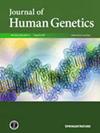A novel case of autosomal-dominant cutis laxa caused by a de novo likely pathogenic variant in ALDH18A1: case report and literature review
IF 2.5
3区 生物学
Q2 GENETICS & HEREDITY
引用次数: 0
Abstract
Cutis laxa is a highly heterogeneous connective tissue disorder characterized by progressively loose skin, often accompanied by systemic involvement. Autosomal dominant cutis laxa (ADCL) has been linked to variants in several genes, including ALDH18A1, which encodes Δ1-pyrroline-5-carboxylate synthetase, a key enzyme in proline and collagen metabolism. We report a novel case of ADCL in a 1.6-year-old patient presenting with growth delay, hypotonia, joint laxity, lax skin, cataract, dysmorphic features, microcephaly, cranial vessel tortuosity, hip dislocation, and psychomotor retardation. Whole-exome sequencing revealed a de novo heterozygous c.400 T > C (p.Ser134Pro) substitution in the ALDH18A1 gene. This variant has not been previously reported, and it is the first report of an individual with ALDH18A1-ADCL due to a substitution at a highly conserved residue, p.Ser134 of the P5CS protein. Our findings expand the mutational spectrum of ALDH18A1-related ADCL and highlight the importance of genetic testing in diagnosing rare disorders.

由ALDH18A1可能的新致病变异引起的常染色体显性皮肤松弛症一例:病例报告及文献复习。
皮肤松弛症是一种高度异质性的结缔组织疾病,其特征是皮肤逐渐松弛,常伴有全身受累。常染色体显性皮肤松弛症(ADCL)与几个基因的变异有关,包括ALDH18A1,它编码Δ1-pyrroline-5-carboxylate合成酶,这是脯氨酸和胶原蛋白代谢的关键酶。我们报告一例1.6岁的ADCL患者,表现为生长迟缓、张力低下、关节松弛、皮肤松弛、白内障、畸形特征、小头畸形、颅血管扭曲、髋关节脱位和精神运动迟缓。全外显子组测序显示,在ALDH18A1基因中出现了一个从头杂合的C .400 T . > C (p.Ser134Pro)替换。这一变异以前没有报道过,这是首次报道的ALDH18A1-ADCL个体,这是由于P5CS蛋白高度保守的残基p.Ser134的替换。我们的发现扩大了与aldh18a1相关的ADCL的突变谱,并强调了基因检测在诊断罕见疾病中的重要性。
本文章由计算机程序翻译,如有差异,请以英文原文为准。
求助全文
约1分钟内获得全文
求助全文
来源期刊

Journal of Human Genetics
生物-遗传学
CiteScore
7.20
自引率
0.00%
发文量
101
审稿时长
4-8 weeks
期刊介绍:
The Journal of Human Genetics is an international journal publishing articles on human genetics, including medical genetics and human genome analysis. It covers all aspects of human genetics, including molecular genetics, clinical genetics, behavioral genetics, immunogenetics, pharmacogenomics, population genetics, functional genomics, epigenetics, genetic counseling and gene therapy.
Articles on the following areas are especially welcome: genetic factors of monogenic and complex disorders, genome-wide association studies, genetic epidemiology, cancer genetics, personal genomics, genotype-phenotype relationships and genome diversity.
 求助内容:
求助内容: 应助结果提醒方式:
应助结果提醒方式:


